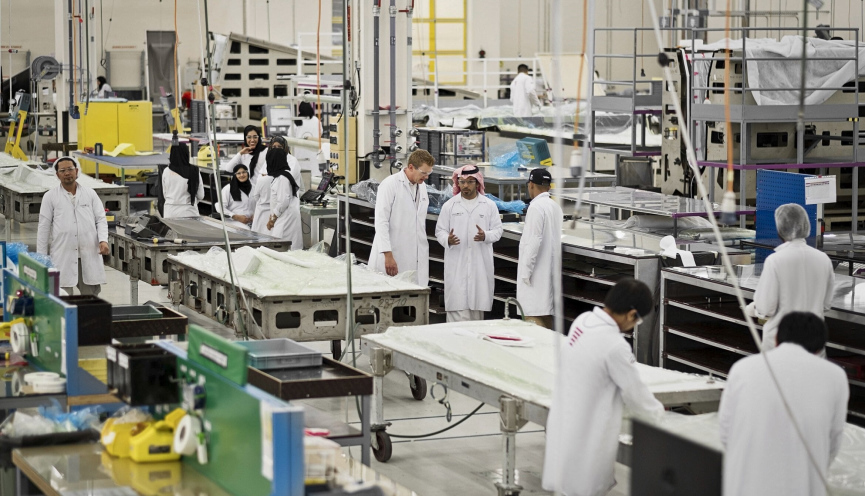Slowdown Signals : UAE’s non-oil private sector has shown signs of cooling as the Purchasing Managers’ Index (PMI) dipped to a six-month low in March 2025, reflecting a modest deceleration in growth momentum across key industries. This comes at a time when global economic uncertainties and shifting demand patterns continue to test the resilience of regional markets.
According to the latest survey data released on April 4, the seasonally adjusted S&P Global UAE PMI fell to 54.2 in March, down from 56.5 in February, marking the lowest level since September 2024. Despite remaining well above the neutral 50.0 threshold—which separates growth from contraction—the decline suggests a moderation in the pace of expansion across the UAE’s robust non-oil economy.
Growth Slows but Remains Strong

The PMI remains firmly in expansionary territory, but the softer reading signals that businesses are growing at a slower pace. Several indicators within the index—such as new orders, output levels, and employment—continued to register growth, albeit at a reduced rate compared to earlier in the year.
“Although March data still reflects a healthy level of activity in the UAE’s non-oil economy, the drop in PMI points to a loss of momentum as businesses navigate increased input costs, extended delivery times, and cautious customer spending,” said a senior economist from S&P Global.

The UAE’s non-oil private sector includes critical industries such as retail, tourism, construction, transport, and financial services—sectors that have been instrumental in diversifying the country’s economy away from oil dependency. The latest PMI results show that while business confidence remains generally optimistic, firms are becoming more guarded in their outlook for growth in the months ahead.
Slowdown Signals :New Orders and Output Growth Eases
A key component of the PMI—the new orders index—showed a slower rate of increase in March, indicating that demand, while still present, is no longer expanding at the same velocity. Surveyed firms reported that while domestic orders remained steady, international demand, especially from key trading partners, experienced some softening.
Output, another major contributor to the headline PMI figure, also rose at a reduced pace. Several businesses cited a “normalization” of demand following a strong start to 2025. Some sectors, particularly retail and hospitality, saw seasonal dips after the peak tourism period concluded in February.
“Client demand is still good, but the post-Expo and post-holiday surge has stabilized,” reported a logistics manager at a Dubai-based firm. “We are now operating in a more balanced environment compared to the first quarter.”
Hiring and Inventory Activity Slows
Employment trends showed modest growth, with firms continuing to hire in response to existing workloads. However, the rate of job creation was the slowest seen in four months, suggesting a cautious approach to workforce expansion.
Similarly, inventory levels rose only marginally in March, reflecting more conservative purchasing strategies. Businesses indicated that while input availability was stable, they were refraining from bulk stockpiling due to concerns about fluctuating demand and cost pressures.
“Supply chains are stable but we’re keeping our orders lean,” noted a procurement head at a Sharjah-based construction firm. “We are watching the market closely before expanding inventory levels.”
Inflationary Pressures and Input Costs Rise
One of the key themes emerging from the PMI report is the uptick in input costs, which rose at the fastest rate in three months. Rising material prices, transportation costs, and currency fluctuations have all contributed to increased operating expenses for businesses.
Despite these cost pressures, output prices—what businesses charge their customers—were largely unchanged. Many firms reported absorbing higher input costs themselves, a sign of intense competition and the desire to maintain market share. This dynamic could put pressure on profit margins in the near term.
“Companies are still cautious when it comes to passing cost increases to customers,” the S&P Global report noted. “This reflects competitive pricing environments and customer sensitivity to price changes.”
Business Confidence Holds Steady
Despite the dip in PMI, overall business sentiment in the UAE remained broadly positive. Firms expressed confidence in their future output and growth potential, citing continued government investment, regional infrastructure projects, and strong consumer activity as reasons to remain optimistic.
The UAE’s proactive approach to economic diversification, investor-friendly reforms, and ongoing efforts to strengthen trade partnerships have played a central role in maintaining business confidence. Initiatives such as the UAE Industrial Strategy and green energy investments are expected to support medium- and long-term growth across the non-oil economy.
Sector Highlights
- Construction & Real Estate: The sector remained stable, with several ongoing projects contributing to sustained activity, especially in Dubai and Abu Dhabi. However, developers reported delays in some approvals and a more conservative approach from clients regarding new ventures.
- Tourism & Hospitality: March saw a slowdown after the winter peak, but forward bookings for summer events and conferences remain strong. The upcoming Eid holidays are expected to boost travel and leisure activity.
- Retail & Consumer Goods: Retailers reported mixed results, with strong performance in e-commerce channels offset by more cautious in-store spending. Discounts and promotional campaigns are expected to drive momentum in Q2.
- Manufacturing & Logistics: Activity remains solid, but cost pressures and global supply chain uncertainties continue to affect planning. Some manufacturers are diversifying sourcing strategies to maintain stability.
Outlook for Q2 2025
Looking ahead, the UAE’s non-oil sector is expected to maintain its growth trajectory, albeit at a moderated pace. Analysts suggest that the current soft patch is a temporary adjustment after months of rapid expansion. Key watchpoints include interest rate trends, geopolitical developments, and global economic performance, especially in major markets like China and Europe.
The UAE government’s focus on attracting foreign direct investment, developing digital economies, and expanding global trade links provides a solid foundation for recovery. Additionally, the expansion of free zones, visa reforms for skilled professionals, and startup-friendly policies continue to support business activity and entrepreneurship.
Conclusion
While the latest PMI reading signals a slowdown in the pace of non-oil sector growth, the UAE economy remains fundamentally strong, resilient, and well-positioned for long-term success. Businesses are adapting to a more measured growth environment, with a focus on cost control, quality service delivery, and innovation.
In an increasingly dynamic global economy, the UAE’s commitment to diversification and forward-looking reforms ensures that its non-oil private sector remains a pillar of sustainable growth. March’s PMI may be a temporary dip—but the trajectory remains firmly pointed toward progress.
Do follow Uae stories for more Updates
Fresh Finds: Sharjah’s Bustling Fish Market Reels in Community Charm














